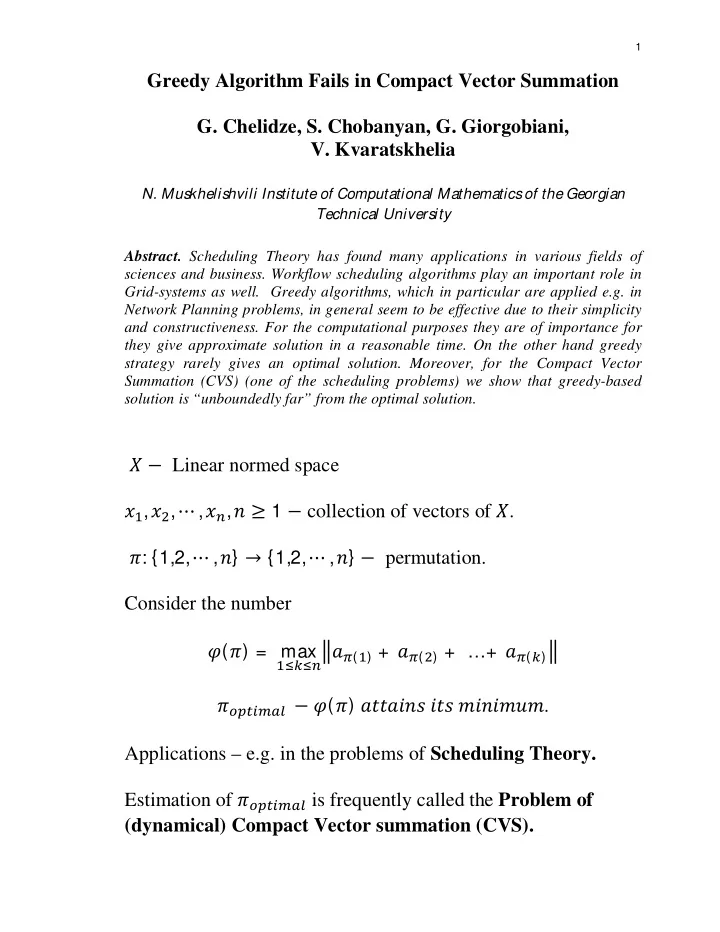

1 Greedy Algorithm Fails in Compact Vector Summation G. Chelidze, S. Chobanyan, G. Giorgobiani, V. Kvaratskhelia N. Muskhelishvili Institute of Computational Mathematics of the Georgian Technical University Abstract. Scheduling Theory has found many applications in various fields of sciences and business. Workflow scheduling algorithms play an important role in Grid-systems as well. Greedy algorithms, which in particular are applied e.g. in Network Planning problems, in general seem to be effective due to their simplicity and constructiveness. For the computational purposes they are of importance for they give approximate solution in a reasonable time. On the other hand greedy strategy rarely gives an optimal solution. Moreover, for the Compact Vector Summation (CVS) (one of the scheduling problems) we show that greedy-based solution is “unboundedly far” from the optimal solution. � − Linear normed space � � , � � , ⋯ , � � , � ≥ 1 − collection of vectors of � . � : {1,2, ⋯ , � } → {1,2, ⋯ , � } − permutation. Consider the number � ( � ) = max ����� �� � ( � ) + � � ( � ) + …+ � � ( � ) � � ������� − � ( � ) ������� ��� ������� . Applications – e.g. in the problems of Scheduling Theory. Estimation of � ������� is frequently called the Problem of (dynamical) Compact Vector summation (CVS).
2 Greedy Algorithm (greedy permutation) to approach � ������� : Step I . Choose � � � = min ����� { ‖� � ‖ } ; Step II. Choose � � � �� �ℎ�� �� � � + � � � � �� ������� , ��� . Computation runs in polynomial time . Is it of the same order as the optimal one? �������� : �� �ℎ��� � �������� � , ��������� ���� �� �ℎ� ����� � ���ℎ �ℎ�� ��� ������ � ≤ ���� ������� � ? In the one-dimensional case the constant � = 2. � � �� ��������� . J. Wojtaszczyk – �� � � �� ������������������������������� (1,1),(2, − 3),( − 3,2), ⋯ ,(1,1),(2, − 3),( − 3,2) ��� ������ � ≥ � ; ��� ������� � = 3 Theorem: For any two-dimensional normed space X (real or complex) and any prescribed number � there exists a collection � � , � � , ⋯ , � � , � ≥ 1 of vectors of X such that ��� ������ � ��� ������� � > � . Proof.
3 � − linear inner product space dim � = 2 ; � : � → � , ��� � = {0}, ‖�‖ = 1, � ∈ � , ‖�‖ = ‖��‖ = 1 Construction : ℎ � ≡ �� , �ℎ���� ℎ � ⊥ ℎ � , ‖ℎ � ‖ = 2 √� , � ≡ � �� ℎ � ; 1 1 1 � � ≡ − √� � , � � ≡ ( � + � ), � � ≡ ( � − � ) √� √� Collection: � ≥ 1 �� ��� �� � �� ����� ��� ��� � � , � � , � � , � � , ⋯ , � � , � � , � � , � � � � + � � + � � + � � = 0 Calculations 1 ‖� � ‖ = , ‖� � ‖ > 2, ‖� � ‖ > 2, √� � ‖ ( � − 1) � � + � � ‖ > ‖�� � ‖ = , � = 1,…, � . √� � ‖ ( � − 1) � � + � � ‖ > ‖�� � ‖ = , � = 1,…, � . √� imply the greedy algorithm: Step I. Choose � � ; Step II. Choose � � ; ⋮ Step n. Choose � � ; ⋮
4 We get � � � ��� �� � � , ⋯ , � � , ⋯ Thus ��� ������ � ≥ ‖�� � ‖ = √� . While for the initial arrangement �� ��� �� � �� ����� ��� ��� � � , � � , � � , � � , ⋯ , � � , � � , � � , � � � ( � ) ≤ 2 ‖� �� ‖ ⇒ ��� ������� � ≤ 2 ‖� �� ‖ . Choose � > 4 � � ‖� �� ‖ � . We get ��� ������ � ��� ������� � > � .
Recommend
More recommend